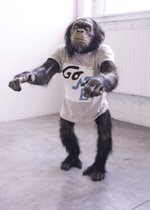5,000,000,000 YEARS until 31.12. Palais de Tokyo, Paris
 5,000,000,000 YEARS is an exhibition that places itself within the FIVE BILLION YEARS chapter by way of a mutation. Synonymous yet clearly dissimilar, the exhibition and the program-chapter that contains it create an endless feedback loop, each one mutating as it transfers back into the other. Like mutants, artists operate in parallel spheres, and like a mutant, art survives by being furtive and by compromising our ability to establish clear interpretive sign-posts. Visually, nothing (or almost nothing) allows one to distinguish a mutant from a human being, and nothing (or almost nothing) allows one to distinguish a work of art from an ordinary object. The difference lies elsewhere. But as soon as a mutant is identified as such, he returns—we see it happen—to his original status of being an extraterrestrial. As soon as a work of art is identified as such, it loses its status as an object only to be transfigured and returned to the world of art. This chronic schizophrenia is a defining characteristic of art-making today. What counts is not the colonization of new worlds but an accumulation of the identical. Art doesn’t invade or abandon one territory at the expense or in favor of another, but it constantly slides in and out of territories and across different spheres and personalities. Today, ontology seems less relevant than the mechanics of contamination. In a universe that is expanding at an irreversibly accelerated rate, the borders that define a work of art can only be blurry. More crucial are the ways in which the work moves back and forth between spheres of knowledge and practice, effectively becoming an uncontainable mutant. The exhibition 5,000,000,000 YEARS explores this elasticity of the work of art, its temporality and impact. Like mutants, some pieces featured in 5,000,000,000 YEARS have already been seen in other venues, notably at SI, New York, as part of the exhibitions FIVE BILLION YEARS (2004), OK / OKAY (2005) and SPACE BOOMERANG (2006). These works fit into a schizophrenia that emphasizes their ability to change according to context and their potential for generating multiple meanings: can a work of art that is displayed in two different venues remain identical? What is the principle guiding its mutation? What is the principle behind its autonomy? CHRISTIAN ANDERSSON / ARTISTS UNKNOWN / MICHEL BLAZY / MIKE BOUCHET / LORIS CECCHINI / PHILIPPE DECRAUZAT / MARCEL DUCHAMP / CEAL FLOYER / URS FISCHER / MARK HANDFORTH / JOACHIM KOESTER / VINCENT LAMOUROUX / LANG-BAUMANN / TONY MATELLI / JONATHAN MONK / FRANЗOIS MORELLET / GIANNI MOTTI / CHARLES RAY (the list is being expanded)
5,000,000,000 YEARS is an exhibition that places itself within the FIVE BILLION YEARS chapter by way of a mutation. Synonymous yet clearly dissimilar, the exhibition and the program-chapter that contains it create an endless feedback loop, each one mutating as it transfers back into the other. Like mutants, artists operate in parallel spheres, and like a mutant, art survives by being furtive and by compromising our ability to establish clear interpretive sign-posts. Visually, nothing (or almost nothing) allows one to distinguish a mutant from a human being, and nothing (or almost nothing) allows one to distinguish a work of art from an ordinary object. The difference lies elsewhere. But as soon as a mutant is identified as such, he returns—we see it happen—to his original status of being an extraterrestrial. As soon as a work of art is identified as such, it loses its status as an object only to be transfigured and returned to the world of art. This chronic schizophrenia is a defining characteristic of art-making today. What counts is not the colonization of new worlds but an accumulation of the identical. Art doesn’t invade or abandon one territory at the expense or in favor of another, but it constantly slides in and out of territories and across different spheres and personalities. Today, ontology seems less relevant than the mechanics of contamination. In a universe that is expanding at an irreversibly accelerated rate, the borders that define a work of art can only be blurry. More crucial are the ways in which the work moves back and forth between spheres of knowledge and practice, effectively becoming an uncontainable mutant. The exhibition 5,000,000,000 YEARS explores this elasticity of the work of art, its temporality and impact. Like mutants, some pieces featured in 5,000,000,000 YEARS have already been seen in other venues, notably at SI, New York, as part of the exhibitions FIVE BILLION YEARS (2004), OK / OKAY (2005) and SPACE BOOMERANG (2006). These works fit into a schizophrenia that emphasizes their ability to change according to context and their potential for generating multiple meanings: can a work of art that is displayed in two different venues remain identical? What is the principle guiding its mutation? What is the principle behind its autonomy? CHRISTIAN ANDERSSON / ARTISTS UNKNOWN / MICHEL BLAZY / MIKE BOUCHET / LORIS CECCHINI / PHILIPPE DECRAUZAT / MARCEL DUCHAMP / CEAL FLOYER / URS FISCHER / MARK HANDFORTH / JOACHIM KOESTER / VINCENT LAMOUROUX / LANG-BAUMANN / TONY MATELLI / JONATHAN MONK / FRANЗOIS MORELLET / GIANNI MOTTI / CHARLES RAY (the list is being expanded)

0 Comments:
Post a Comment
<< Home